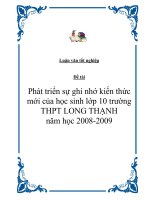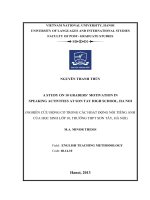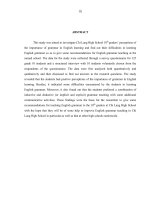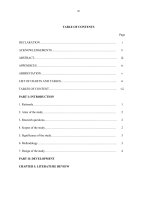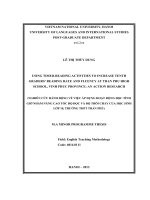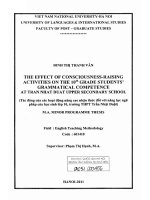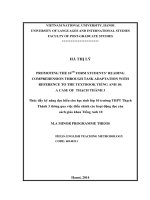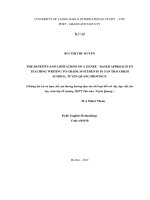Nhận thức của học sinh lớp 10 trường THPT Chi Lăng về tầm quan trọng của ngữ pháp trong việc học tiếng Anh về những khó khăn của họ khi học ngữ pháp tiếng Anh
Bạn đang xem bản rút gọn của tài liệu. Xem và tải ngay bản đầy đủ của tài liệu tại đây (1.89 MB, 63 trang )
iii
ABSTRACT
This study was aimed to investigate Chi Lang High School 10
th
graders’ perceptions of
the importance of grammar in English learning and find out their difficulties in learning
English grammar so as to give some recommendations for English grammar teaching at the
named school. The data for the study were collected through a survey questionnaire for 125
grade 10 students and a structured interview with 10 students voluntarily chosen from the
respondents of the questionnaire. The data were first analyzed both quantitatively and
qualitatively and then discussed to find out answers to the research questions. The study
revealed that the students had positive perceptions of the importance of grammar in English
learning. Besides, it indicated some difficulties encountered by the students in learning
English grammar. Moreover, it also found out that the students preferred a combination of
inductive and deductive (or implicit and explicit) grammar teaching with some additional
communicative activities. These findings were the basis for the researcher to give some
recommendations for teaching English grammar to the 10
th
graders at Chi Lang High School
with the hope that they will be of some help to improve English grammar teaching in Chi
Lang High School in particular as well as that at other high schools nationwide.
iv
TABLE OF CONTENTS
DECLARATION …………………………………………………………………… …….i
ACKNOWLEDGEMENTS …………………………………………………….………….ii
ABSTRACT ……………………………………………………………………………….iii
TABLE OF CONTENTS ………………………………………………………………….iv
LIST OF TABLES AND ABBREVIATIONS………………………………………… vii
PART A: INTRODUCTION…………………………………………………………… 1
1. Rationale ………… ………………………………………………………………1
2. Objectives of the study…………………………………… …………………… 2
3. Research questions………………………………………………………………….2
4. Research methods ….…………………………………………………….……… 2
5. Scope of the study………………………………………………………………… 3
6. Significance of the study……………………………………………………………3
7. Design of the study………………………………………………………………….3
PART B: DEVELOPMENT ………………………………………………….………….5
CHAPTER 1: LITERATURE REVIEW …………………………………… ……… 5
1.1. Definitions of grammar …………………………………………….… ………… 5
1.2. The place of grammar in foreign language teaching …………… ……………… 6
1.2.1. For-grammar perspectives …………………………………………….… 6
1.2.2. Against-grammar perspectives …………………………………………… 7
1.3. Some approaches to grammar teaching ………………… ……………………….8
1.3.1. Implicit and explicit approaches to grammar teaching ………………… 8
1.3.2. Deductive and inductive approaches to grammar teaching …………… 10
1.3.2.1 The deductive approach …………………………………………….10
v
1.3.2.2 The inductive approach ……………………………………………11
1.4. Some research on learner perceptions of grammar teaching …………………….13
1.5. Learner variables ………………… 14
1.6. Concluding remarks …………………………………………………… ……….15
CHAPTER 2: THE STUDY …………………………………….………………………16
2.1. Setting of the study ………………………………………………….……………16
2.2. Methodology…………………………………… ……………………………….17
2.2.1. Research questions……………………………………… ……………….17
2.2.2. Subjects of the study ………………………………………………………17
2.2.3. Data collection instruments…………………………………….………… 18
2.2.3.1. The questionnaire…………………………………………… 18
2.2.3.2. The interview ………………………………………………………19
2.2.4. Data collection procedures………………………………………………….19
2.2.5. Data analysis procedures……………………………………………………20
2.3. Concluding remarks …………………………………………………………… 20
CHAPTER 3: DATA, DATA ANALYSIS AND DISCUSSION …………………… 21
3.1. Data of and findings from the questionnaire ………… …………………………21
3.1.1. Students’ perceptions of the necessity of learning English …………………21
3.1.2. Students’ purposes for learning English …………………………………….22
3.1.3. Students’ perceptions of the importance of grammar in
English learning 23
3.1.4. The ways a grammatical point is usually taught ……………… 24
3.1.5. Students’ level of understanding of the teachers’ grammar
instruction ……………………………………………………………………25
3.1.6. Students’ evaluation of the teachers’ presentations of grammar ……………26
3.1.7. Students’ evaluation of grammar parts in the new standard
textbook - Tieng Anh 10 ……………………………………………… 27
vi
3.1.8. Students’ difficulties in learning grammar ………………………… 27
3.1.9. Students’ evaluation of the most effective way of learning
grammar ………………………………………………………………… 29
3.1.10. Students’ preferred styles of grammar teaching ………………………… 30
3.2. Data of and findings from the interview ……………………………………………31
3.3. Discussion of the findings ………………………………………………………….33
3.4. Summary of the main findings……………………………………………… 35
PART C: CONCLUSION …………………………………………… ………………….36
1. Conclusions … …………….………………………………………………….… 36
2. Recommendations for teaching English grammar to the 10
th
graders
at Chi Lang High School 37
3. Limitations of the study ………………………………………………………………39
4. Suggestions for further study ………………………………………………… …….40
REFERENCES ……………………………………………………… ……………… 41
APPENDICES……………………………………………………………………………….I
Appendix 1: Survey questionnaire ……… ………………………………………………I
Appendix 2: Interview questions …………………………………………………….… V
Appendix 3: Interview transcripts ………………….………………………………… V
Appendix 4: Some communicative activities …………………………………… VII
Appendix 5: Some examples of using games, pictures, and songs
to introduce grammatical points……………………………………………XI
vii
LIST OF TABLES AND ABBREVIATIONS
I. LIST OF TABLES
- Table 1: Students’ perceptions of the necessity of learning English
- Table 2: Students’ purposes for learning English
- Table3: Students’ perceptions of the importance of grammar in English learning
- Table 4: The ways a grammatical point is usually taught
- Table 5: Students’ level of understanding of the teachers’ grammar instruction
- Table 6: Students’ evaluation of the teachers’ presentations of grammar
- Table 7: Students’ evaluation of grammar parts in the new standard textbook –Tieng Anh
10
- Table 8: Students’ difficulties in learning grammar
- Table 9: Students’ evaluation of the most effective way of learning grammar.
- Table10: Students’ preferred styles of grammar teaching
II. ABBREVIATIONS
- EFL: English as Foreign Language
- ESL: English as Second Language
- MOET: Ministry of Education and Training
1
PART A: INTRODUCTION
1. Rationale
The value of grammar instruction has been argued by numerous people involved in the
field of language teaching. In fact, no other issue has so preoccupied theorists and
practitioners as the grammar debate, and the history of language teaching is essentially the
history of the claims and counterclaims for and against the teaching of grammar (Thornbury,
2004). In the early twentieth century, priority was given to grammar teaching with the
argument that if one knew the grammatical rules of the language, he would be able to use it for
communication. However, this argument was called into question in the early 1970s for it was
thought that in order to be considered a competent user of a language, one needed to know not
only the rules of grammar, but also how the rules were used in real communication. Therefore,
grammar teaching became less prominent, and in some cases, was abandoned during this
period. In recent years, a growing concern about accuracy in learners’ language has resulted in
a reassertion of the role of grammar in syllabus design and the content of lessons, and even in
giving explicit attention to grammatical forms and rules (Ellis, 1993c quoted in Hedge, 2000).
It is clear from this brief history of language teaching that grammar teaching has had such a
crucial role in language instruction that it can not be neglected.
Foreign language teaching in Vietnam, particularly English language teaching, has
long been considered to be grammar-focused. It can be inferred from this that grammar
teaching has always been central to foreign language teaching. In fact, teachers of English at
Chi Lang High School always pay much more attention to teach grammar than language skills
and other language knowledge. This is mainly due to the school final examination, which is
mainly grammar-based with their students’ pass rate as an indicator of the teachers’ success.
And for many of the students here, learning English is synonymous with learning its grammar.
Therefore, when learning English, they chiefly focus on grasping its grammar. However, they
have not been much successful in mastering it for, in reality, they often speak and write
ungrammatically, and mistake grammar structures, especially when they do English written
tests and exams which contain different grammar structures. Obviously, these students value
2
grammar learning and spend much time on it, but they have difficulty distinguishing and
memorizing grammar structures. Moreover, up to now, there has not been any research on this
problem at Chi Lang High School. All of these reasons inspired me to conduct the survey
research entitled “Chi Lang High School 10
th
graders’ perceptions of the importance of
grammar in English learning and their difficulties in learning English grammar.”
2. Objectives of the study
With the above-mentioned rationale, the objectives of the study are:
To investigate Chi Lang High School 10
th
graders’ perceptions of the importance of
grammar in English learning;
To find out Chi Lang High School 10
th
graders’ difficulties in learning English grammar;
To give some recommendations for teaching English grammar to the 10
th
graders at Chi
Lang High School.
3. Research questions
To achieve the objectives of the study, the following research questions were proposed:
1. What are Chi Lang High School 10
th
graders’ perceptions of the importance of
grammar in English learning?
2. What are Chi Lang High School 10
th
graders’ difficulties in learning English grammar?
3. What are Chi Lang High School 10
th
graders’ preferred styles of teaching English
grammar?
4. Research methods
This is a survey research which utilized both quantitative and qualitative methods. And
two sources of data were used to achieve the objectives of the study and answer the research
questions:
Investigating students’ perceptions of the importance of grammar in English learning,
finding out their difficulties in learning English grammar as well as their preferred styles of
teaching English grammar through a questionnaire. The questionnaire included both closed
and open-ended questions to ensure deep data. The data from the questionnaire were analyzed
both quantitatively and qualitatively.
3
Interviewing 10 students to get more in-depth information for the study as well as get
their suggestions for grammar teaching lessons at school. The interview was a structured one.
5. Scope of the study
The study is only aimed at investigating Chi Lang High School 10
th
graders’
perceptions of the importance of grammar in English learning, finding out their difficulties in
learning English grammar, and giving some recommendations for teaching English grammar
to the 10
th
graders at Chi Lang High School. Therefore, their perceptions of the importance of
language skills and other language knowledge as well as their difficulties in learning them will
be beyond the scope of this study. And the findings of the study are not intended to be
generalized to other high school graders in Vietnam.
6. Significance of the study
It is hoped that the results of the study will help the teachers of English in Chi Lang
High School clearly understand the 10
th
graders’ perceptions of the importance of grammar in
English learning, their difficulties in learning English grammar, and their preferred styles of
teaching English grammar. And the recommendations for English grammar teaching will be
beneficial to the teachers here in particular as well as those who concern English grammar
teaching at high schools nationwide.
7. Design of the study
The study includes three parts: the Introduction, the Development and the Conclusion.
Part A: Introduction - deals with the rationale, objectives, research questions, methodology,
scope, significance and design of the study.
Part B: Development – consists of three chapters
Chapter 1: Literature review – provides some theoretical background about
grammar, grammar teaching, learner perceptions of teaching grammar, and learner
variables.
Chapter 2: The study – presents the setting of the study, research questions, subjects
of the study, data collection instruments, data collection procedures and data analysis
procedures.
4
Chapter 3: Data, Data Analysis and Discussion – shows data of and major findings
from the questionnaire and interview, and discussion of the findings.
Part C: Conclusion - presents conclusions, recommendations for teaching English
grammar to the 10
th
graders at Chi Lang High School, limitations of the study, and
suggestions for further study.
5
PART B: DEVELOPMENT
CHAPTER 1: LITERATURE REVIEW
Throughout the history of foreign language teaching, grammar and grammar teaching
have always been of a big concern among educational researchers, linguists, methodologists
and language teachers. Different definitions of grammar, views of and approaches to grammar
teaching have been proposed. This chapter deals with some definitions of grammar, the place
of grammar in foreign language teaching, some approaches to grammar teaching, some
research on learner perceptions of grammar teaching, and learner variables.
1.1 Definitions of grammar
As cited in Harmer (1987), The Longman Dictionary of Contemporary English defines
grammar as “the study and practice of the rules by which words change their forms and are
combined into sentences”. Accordingly, the rules of grammar, and the study and practice of
the rules are two basic elements in this definition; and the rules of grammar are about how
words change and how they are put together into sentences.
Celce-Murcia and Hilles (1988) have the same opinion of grammar: “we can think of
language as a type of rule-governed behavior. Grammar, then, is a subset of those rules which
govern the configurations that the morphology and syntax of a language assume”.
It can be drawn from the two definitions above that grammar just refers to rules to
combine words to make sentences. But a question needs answering is that what these
sentences are used for?
According to Bastone (1994), grammar is divided into product (the component parts or
rules that makes up the language) and process (the ways in which grammar is deployed from
moment to moment in communication). Clearly, Bastone’s view of grammar not only
concerns rules but also rules of use.
6
Richards, Platt, and Platt (1992) write in their Longman Dictionary of Language
Teaching & Applied Linguistics: “Grammar is a description of the structure of a language and
the way in which linguistic units such as words and phrases are combined to produce
sentences in the language. It usually takes into account the meanings and functions these
sentences have in overall system of the language. It may or may not include the description of
the sound of a language.”
I favor Richards, Platt, and Platt’s (1992) definition of grammar. Because, in this
definition, grammar is viewed as descriptive, which refers to the structure of a language as it is
actually used by speakers and writers. Furthermore, the definition indicates both linguistic and
social features of grammar as it refers to not only rules to make correct sentences but also
meanings and functions of such sentences in the language, which is essential for foreign
language teaching and learning.
1.2 The place of grammar in foreign language teaching
Grammar teaching has always received much attention from people who interest in
language and language teaching and learning. According to Celce-Murcia and Hilles (1988:
1), “of the many issues surrounding the teaching of grammar, perhaps the most controversial
is whether to teach it at all”. From a historical perspective, this controversy should come as
somewhat of a surprise: teaching grammar has been central to and often synonymous with
teaching foreign language for the past 2,500 years (Rutherford, 1987 quoted in Celce-Murcia
and Hilles, 1988). However, the 1980s experienced an anti-grammar movement, perhaps
influenced primarily by Krashen’s (1987) idea is that grammar can be acquired naturally from
meaningful input and opportunities to interact in the classroom (Hedge, 2000). Some
arguments for and against grammar will be introduced briefly below.
1.2.1 For-grammar perspectives
The role of grammar in foreign language teaching and learning has been acknowledged
by many scholars in the field. Typically, Canale and Swain (1980) admit the importance of
grammar when seeing grammar as one of four components of communicative competence and
learners can communicate effectively only in a limited number of situations without grammar.
In favor of Canale and Swain, Brown (2007) points out that “grammatical competence
7
occupies a prominent position as a major component of communicative competence”. Long
and Richards (1987) also claim that grammar plays a central role in the four language skills
and vocabulary to establish communicative tasks.
Moreover, Rutherford and Smith (1988) state that grammar can be beneficial to
learners in the sense that it raises learners consciousness concerning the differences and
similarities of first language and second language. So, grammar teaching can be used as a
“linguistic map” with road signs to help students as they explore the “topography” of the new
language. As a supporter of grammar teaching, Hannan (1989) argues that grammar is highly
valuable as an important part of the study of language, of ideas and of writing. He also
concludes that grammar reflects the power and order of the human mind and, besides, it helps
us to understand the diversity of human culture. In addition, from Palmer’s (1984) viewpoint,
the central part of a language is its grammar, and this should be of “vital interest to any
intelligent educated person. If it has not been of such interest, then the fault must be in the
failure to recognize its importance within this essentially human activity”.
Mentioning the significance of grammar teaching, Smith (2001) assumes that if
teachers do not pay attention to grammar nor create opportunities for learners to improve their
grammar, they are likely to stand the risk of fossilization or reach a point where they can cope
with level of communication that is demanded of them by making use of their existing
grammatical resources and communication strategies and probably with sufficient fluency not
to see the need to develop their linguistic abilities any further. In short, grammar is
acknowledged to be of importance in language study and foreign language teaching and
learning. This partly explains Hedge’s (2000) idea that recent years have seen a resurgence of
interest in the role of grammar in English language teaching.
1.2.2 Against-grammar perspectives
It is undeniable that although many language learners know the grammar rules of a
language well, they have many difficulties communicating effectively in that language.
Therefore, some people suspect that grammar teaching will lead to good communication and
disregard it. For instance, Krashen (1987), the most prominent supporter of anti-grammar
view, whose learning and acquisition hypothesis and his Monitor theory are very well-known.
8
In his learning and acquisition hypothesis, Krashen argues that from learning the learners
obtain conscious knowledge of grammar which is not responsible for actual second language
performance. On the other hand, acquisition is the underlying process which is responsible for
the actual performance and this can only happen unconsciously through natural exposure to
comprehensible inputs. Moreover, according to his Monitor theory, consciously-learned
grammar can only function as monitoring and monitoring overuse will only disturb the flow of
production. Consequently, this grow-up holds that formal and conscious study of grammar
should be strongly rejected if the objective of learning the language is productive competence.
To sum up, grammar plays a crucial part in language teaching for grammar is one of
three key components of a language. So, one cannot master a language without the knowledge
of its grammar. Partly thanks to grammar, language can function as a means of
communication, especially in written language. A person cannot write well if he lacks the
knowledge of grammar. Moreover, according to Peck (1988), grammar exists to enable us to
‘mean’ and without it, it is impossible to communicate beyond a very rudimentary level
because speech is no more than sounds, writing is no more than hieroglyphics. Although there
was a time when grammar was severely rejected, in recent years grammar teaching has
regained its rightful place in the language teaching and “grammar is too important to be
ignored” (Richards, 2002).
1.3 Some approaches to grammar teaching
As mentioned above, grammar is so important to language teaching that it can not be
neglected. Now the issue is that how to teach it effectively. Numerous approaches to and
methods of grammar teaching have been proposed throughout the history of language teaching
in general and foreign language teaching in particular. Below are four major approaches in
detail.
1.3.1 Implicit and explicit approaches to grammar teaching
Scott’s (1990) viewpoint of implicit and explicit approaches is as follows: the implicit
9
approach emphasizes that students should be exposed to grammatical structures in a
meaningful and comprehensible context in order that they may acquire as naturally as possible
the grammar of the target language; in contrast, the explicit approach insists upon the value of
deliberate study of a grammar rule in order to organize linguistic elements efficiently and
accurately. According to DeKeyser (1994), implicit teaching of grammar means that no rules
are formulated; explicit means rules are formulated (either by the teacher or the student, either
before or after examples/practice).
For scholars who advocate an implicit approach to grammar teaching, students will
develop “naturally” all the grammatical competence they need to communicate effectively if
they are exposed to comprehensible, meaningful linguistic input. Indeed, Krashen and his
colleagues (Krashen, 1987; Krashen & Terrell, 1983) led the evolution against explicit
grammar teaching. The distinction that Krashen makes between “learning” (a conscious
process) and “acquisition” (a subconscious process) forms the basis of his theory of implicit
teaching strategies. He maintains that second language acquisition can take place in the
classroom without the explicit study of grammar if students are exposed to enough
comprehensible input. Moreover, according to Krashen & Terrell (1983), the conscious study
of grammar does not aid in the natural acquisition process as “…grammar exercises…can be
valuable as tool to encourage learning. However, it should be kept in mind that while their
function is important, very little acquisition will take place during their use”.
However, Krashen’s hypothesis has been criticized by many scholars as it is not
validated by experimental evidence. For instance, Lopéz (2004) and Andrews (2007) carried
out experimental studies on the effects of implicit-explicit grammar instruction on EFL and
ESL students’ performance. The results indicate that students who were taught the target
structures explicitly performed better than those who received the implicit method of
instruction. Moreover, Celce-Murcia (1991) warns that the implicit approach “can lead to the
development of a broken, ungrammatical pidginize from of the target language beyond which
students rarely process” (p. 162). Such learners, she explains, are often said to have fossilized
in their acquisition of the target language. In addition, there are many other advocates of the
10
explicit method of grammar instruction. Mclaughlin (1990) supports the value of explicit
grammar teaching by distinguishing between controlled processing and automatic processing
in learning a foreign language. He stresses that language skills are learned and become
automatic only after the use of controlled process. In other words, students develop automatic
control of a grammatical structure after passing through a deliberate, conscious stage of
learning grammatical rule and their application. In addition, Savignon (1991) points out that
while involvement in communicative event is seen as central to language involvement, this
involvement necessarily requires attention to form or explicit language teaching.
In a word, each above-mentioned approach to grammar teaching has its own strengths
and which one is chosen as the leading approach to grammar teaching depends on many
factors such as, learning and teaching contexts, learners’ learning motivation and styles,
teachers’ competence, etc.
1.3.2 Deductive and inductive approaches to grammar teaching
1.3.2.1 The deductive approach
In the deductive approach, a grammatical rule is first presented explicitly by the
teacher and examples applying the rule will follow. Next the students practice the rule with
various kinds of exercises, for example drills and translation into and out of the target
language. The deductive approach is also often compared with other more traditional methods
of grammar teaching. It aims at teaching various grammatical rules one at a time through
presentation and explanation by the teacher. Moreover, it is seen to facilitate the learners’
acquisition by “making learners notice structures that they might not otherwise have noticed”
(Ellis 1993, 1995, as quoted in Ruin 1996:104). This is done by giving the learners explicit
interpretations and time to internalize the rule instead of making them to use or produce
structures they cannot yet fully master. Also, as the approach gives the teacher a simple and
quick way for teaching the rules, there will be more time for practicing the structure. Actually,
according to Smith (1980, as quoted in Rutherford and Smith 1988:109), explicit instruction
that focuses on form outside its context can result in deeper learning than natural acquisition.
11
On the other hand, knowing explicitly about a rule does not necessarily mean that it is truly
acquired. As a matter of fact, Shaffer (1989:395) thinks that students might not fully
understand the rule from the presentation and do not really know how to actually use
it. Decoo (1996:107) agrees with Shaffer but sees also that examples can help the learners to
acquire the rule. The deductive approach has also been blamed for making the learners’ role
rather passive as much of the attention is focused on the teacher explaining the rules and
showing the examples. Moreover, usually the grammar instruction is given by using the
learners’ mother tongue, thus leaving little opportunity for them to hear or practice the target
language. According to Thornbury (2004:30), especially young learners might not yet have
sufficient metalanguage to understand the abstract grammar concepts involved as they may
not have yet been taught about them in their mother tongue, and therefore, might lose
their interest. Besides, this approach to grammar can lead to a wrong conception that knowing
the rules is all that is needed to learn a language. However, it is still used in language teaching
for it is traditional, time-saving, and confirms many students’ expectations about classroom
learning effectiveness but recently the interest has been towards more communicative
approaches. Next I will present the inductive approach and its view of grammar teaching.
1.3.2.2 The inductive approach
The inductive approach, in its turn, moves from specific to general. The learners are
first shown many examples containing a certain grammatical structure in different contexts
and they have to work out the rules by themselves. Next the learners apply the rules with
various exercises and in different contexts to learn how they actually work in real language
use. Yet here theorists have differing opinions about whether or not the rule should be
verbalized at all. Some consider it to be helpful for the learners but others think it only
disturbs the process of acquisition (Decoo 1996:97). This approach is also often compared
with the Audio-Lingual method that sees language learning as habit formation where,
according to Shaffer (1989:395), learners will learn the structure through examples until it
becomes automatic. He also thinks that the students will not know what they are learning
unless the teacher gives the explanation to them. Grammar is here presented in context
12
and the learners can consciously work with the language. In fact, consciousness-raising
is seen as an important feature in language learning as it focuses learners’ attention
actively on a grammatical structure through examples and guides them to work out the
rules of the target language themselves, instead of giving them everything ready and waiting
(Ruin 1996:106). This approach also involves the learners in a more active participation and
as they need to figure out the rules by themselves, the learners will remember and acquire
them better than just by hearing them from the teacher. Despite the advantages of the
inductive approach, it might not always be a good way to approach a grammar item. Firstly, it
can be very time consuming as the teacher has to create the many examples needed to
demonstrate the rules well enough and it might also take much time for the learners to
actually discover the rules. The time taken to the discovery might not leave enough room for
exercises and in this case the learners could only depend on their own conclusions. Secondly,
the learners might hypothesize the wrong rules which might lead to incorrect assumptions of
the grammar item (Thornbury 2004:54). Now, if the rules are not verbalized at all, it
might be very difficult later to unlearn what the learners have originally acquired and,
thus, it could lead to bad habits in real language use. Again, the researchers are not completely
satisfied with the method although many have found it functional. Here the learners get to
participate more but, on the other hand, this participation might lead to incorrect knowledge
about the language and also take time from actually practising the rules.
To sum up, although quite much research has been done comparing the approaches, the
various studies have not shown big differences in favour of either one of them. Some have
found supporting results for the one but then another study shows better results for the other.
Corder (1988, as quoted by Ruin 1996:109) sees the pros of both of the approaches, as
according to him, in the deductive approach the learners’ attention is directed to the problem
by giving the rules first to raise their awareness of it, whereas by giving the examples first in
the inductive approach the learners are encouraged to use their own intuitions and
observations to figure out the rules by themselves. Therefore an ideal syllabus might be to use
both deductive and inductive approaches together depending on the topic and its level of
difficulty.
13
1.4 Some research on learner perceptions of grammar teaching
In order to attain the goal of a new curriculum, particularly one that is learner-
centered, it is very important to know learner perceptions. Because, according to Eva Bernat
(2008), perceptions and beliefs play a significant role in directing human behavior and how
students’ beliefs have the potential to shape their cognitive and affective processes in the
classroom and impact on their actions. Up to now, there have been several studies on issues
related to learner perceptions of foreign language teaching and learning in general and
grammar teaching and learning in particular.
Some research conducted in foreign language situations reveals that students find error
correction and grammar instruction helpful in language learning. In fact, Schulz’s (1996, cited
in Anne Pazaver and Hong Wang, 2009) study on students’ and teachers’ views on error
correction and the role of grammar instruction in a foreign language setting indicates that
many students had a more favorable attitude towards grammar instruction than their teachers.
The students also believed that in order to master a language, it was necessary to study
grammar. Peacock (1998, quoted in Anne Pazaver and Hong Wang, 2009) finds that learners
were much in favor of error correction and grammar exercises.
Horowitz (1990, cited in Anne Pazaver and Hong Wang, 2009) claims that there is
often a mismatch in perception between students and teachers on the use of grammar and that
this may often result in negative effects. The goal of her study was to determine students’
beliefs on language learning so that teachers could bear them in mind while teaching. Kern
(1995, quoted in Anne Pazaver and Hong Wang, 2009) believes that an awareness of this
mismatch is important in understanding conflicts that could result in lack of motivation or
anxiety.
In their study on Asian Students’ Perceptions of Grammar Teaching in the ESL
Classroom, Anne Pazaver and Hong Wang (2009) find out that although having similar
cultural and educational backgrounds, the Asian students’ perceptions of form-focused
instruction varied widely. Their different perspectives were based on their previous language
learning experiences, their language proficiency, current academic needs, and future career
choices.
14
In short, it is important to not only be aware of students’ perceptions of the role of
grammar in language learning, but also to understand how these ideas about language learning
were formed. It may be that students’ prior language learning experiences shaped their
perceptions. Alternatively, their teachers’ beliefs about language may contribute to their
choice of teaching methods, which in turn may contribute to the shaping of the perceptions of
their students.
1.5 Learner variables
With regard to the type of grammar instruction or grammar activities appropriate for
ESL or EFL learners and when or how to teach grammar, teachers need to consider the
following learner variables proposed by Celce-Murcia (1991). Firstly, language learners have
different learning strategies or styles. Some learners, consciously or unconsciously, have an
analytic style and learn best by formulating and testing hypotheses or “rules.” Other learners
have a holistic style and learn best by experiencing, gathering, and restructuring relevant data
but doing little or no apparent analysis. Secondly, age is an important learner variable in
helping ESL/EFL teachers decides the extent to which they should focus on form. If the ESL
learners concerned are young children, it is most likely that little explicit grammar instruction
is needed. If the students are adolescents or adults, however, their learning may well be
facilitated by some explicit focus on form. Thirdly, proficiency level is also a variable. If the
ESL students are beginners (regardless of age), there is little justification in focusing on form.
However, if the learners are at the intermediate or advanced level, it may well be necessary for
the teacher to provide some form-related feedback and correction in order for the learners to
progress. Fourthly, the educational background of the students is another learner variable. If
students are preliterate with little formal education, then it is probably not very productive to
focus extensively on form. Even this population (i.e., preliterate or semiliterate adults with
little formal education) may demand some grammar because of cultural expectations regarding
what constitutes language instruction. While they may not benefit linguistically from grammar
instruction, the teacher who satisfies their cultural expectations with some grammar may then
do other things that will be beneficial and which the students will accept. On the other hand, if
15
the students are literate and well educated, they may become frustrated and annoyed if the
teacher does not provide adequate opportunity for them to focus on the formal aspects of the
target language, which would, of course, include correction of their errors and answers to their
questions. Clearly, “there is no single method or approach that can work…for all learners or
under all conditions” (Canh, 2004: 95).
1.6 Concluding remarks
This chapter has provided the literature review related to the research questions. It
includes the definitions of grammar, the place of grammar in foreign language teaching, four
approaches to grammar teaching, some research on learner perceptions of grammar teaching,
and learner variables. The literature review is the basis for the researcher to design the survey
questionnaire and interview, then to analyze the data gathered as well as to propose some
recommendations for teaching English grammar to the 10
th
graders at Chi Lang High School.
16
CHAPTER 2: THE STUDY
This chapter describes the setting of the study. Besides, the methodology of the study
is also introduced in detail.
2.1 Setting of the study
Chi Lang High School was established in 1965 and is located in Chi Lang district in
Lang Son, a mountainous province in the north-east of Vietnam. The school is about 40
kilometers from the center of Lang Son and fourth biggest high school in Lang Son province
with 30 classrooms of which three are computer-equipped and three are equipped with
overhead projectors.
In terms of students, most of them come from ethnic minorities and the majority of
their parents are farmers with low incomes. Therefore, the students here do not have best
learning conditions. As a result, their average level is lower than that in other schools in the
province. And due to level of the students, the Basic Stream is prescribed by the school’s
board of administrators as the only stream for its students to pursue. According to the
curriculum proposed by the MOET, English is a compulsory subject for high school students,
and students pursuing the Basic Stream have three English classes per week and each class
lasts for forty five minutes. Grade 10 students at Chi Lang High School all studied English
with the new textbooks designed by the MOET for four years at lower-secondary schools.
However, the lower-secondary school students here do not have to take any English
examinations in order to be qualified for the lower-secondary school diploma or pass the grade
10 entrance examination, so they often pay little attention to English learning as a result their
English is very limited.
With regard to teaching materials, teachers and students in high schools in Vietnam are
working with two new sets of English textbooks: the standard textbooks and the advanced
ones. The standard textbooks are for students studying in the Basic Stream and Natural
Science Stream; the advanced textbooks are for those studying in The Social Science Stream.
And these textbooks, according to the MOET, are aimed at developing students’
communicative competence. The Basic Stream is chosen by Chi Lang High School’s board of
17
administrators as the only stream for its students, so the English textbooks currently used by
teachers and students here are the standard ones.
Concerning the teaching staff, six teachers of English are working at Chi Lang High
School and all of them are females. Their ages are from 23 to 50 and their teaching experience
ranges from 1 to 26 years. These teachers all graduated from Vietnam National University,
College of Foreign Languages, four of them took part in in-service course and the rest took
part in regular course. The teachers are completely devoted to their teaching job, enthusiastic
and supportive to their students as well as to their colleagues.
2.2 Methodology
2.2.1 Research questions
In order to find out Chi Lang High School 10
th
graders’ perceptions of the importance of
grammar in English learning and their difficulties in learning English grammar so as to give
some recommendations for teaching English grammar to the 10
th
graders at Chi Lang High
School, the research focuses on answering three following questions:
1. What are Chi Lang High School 10
th
graders’ perceptions of the importance of
grammar in English learning?
2. What are Chi Lang High School 10
th
graders’ difficulties in learning English grammar?
3. What are Chi Lang High School 10
th
graders’ preferred styles of teaching English
grammar?
2.2.2 Subjects of the study
The subjects of the study consisted of 125 students at Chi Lang High School in Lang
Son.
The study was applied to three 10
th
classes at Chi Lang High School in Lang Son. The
three classes make a total of 125 participants, both male and female. These students were aged
from 16 to 17. The study was carried out at the end of 2
nd
semester with its subjects were grade
10 students for they are assumed to have something to tell about grammar teaching and
learning after one year studying English; besides, they are also believed to have more free
time and be more enthusiastic to take part in the study.
18
2.2.3 Data collection instruments
The researcher used two instruments to collect data for the study, questionnaire and
interview, with the hope to ensure the reliability and the objectiveness of the study.
2.2.3.1 The questionnaire
The questionnaire seems to be the most common method of data collection in second
language research. Dornyei (2003) states that the popularity of questionnaires is due to the fact
that they are easy to construct and uniquely capable of gathering a large amount of
information quickly in a form that is readily processable. Items in questionnaires can be open-
ended in format, allowing respondents to reply in their own words, or closed, requiring the
respondents to select one from among a limited number of responses. While closed question
formats, such as multiple choice, are useful for obtaining quantitative information and are
easier to analyze, open-ended questions can be useful for gathering qualitative information and
for discovering new variables in responses.
For the objectives of the study are to find out students’ perceptions of the importance
of grammar in English learning and their difficulties in learning English grammar to give
some recommendations for teaching English grammar to the 10
th
graders at Chi Lang High
School, the researcher decided to use only one questionnaire for the students and it consisted
of 10 closed and open-ended questions. The questionnaire had been piloted on 15 students
from three different classes and it was revised basing on the responses before being given to
the target students at the end of the second term of the school year 2010 – 2011. All questions
were written in Vietnamese in order that the students have a clear understanding of the
questions before answering them and are able to express their thoughts more easily in open-
ended questions. The purpose of the questionnaire was to investigate:
- students’ general attitudes towards the necessity of learning English
- students’ purposes of learning English
- students’ perceptions of the importance of grammar in English learning
- the ways a grammatical point is usually taught
- students’ level of understanding of the teachers’ grammar instruction
- students’ evaluation of the teachers’ presentations of grammar
19
- students’ evaluation of grammar parts in the new standard textbook - Tieng Anh 10.
- students’ difficulties in learning grammar
- students’ evaluation of the most effective way of learning grammar.
- students’ preferred styles of grammar teaching.
2.2.3.2 The interview
Along with the questionnaire, an interview with the students was designed. It was the
structured one and consisted of two questions which aimed at finding out whether the students
focused on learning grammar or not, and getting the students’ suggestions for better grammar
lessons. 10 students were voluntarily chosen from the questionnaire respondents to participate
in this interview.
The language used in the interview was Vietnamese in order that the interviewees would
fully understand all the questions and be more comfortable to express their answers.
2.2.4 Data collection procedures
The copies of the questionnaire were delivered to 125 students from three different
classes which were randomly selected among 12 grade 10 classes at Chi Lang High School
during their last English classes of the second term. And the researcher herself delivered the
copies to the participants. Before the participants wrote their answers, all of them had been
informed in Vietnamese about the purposes of the questionnaire and how to answer all the
questions so that they were clear about what and how they would have to do. When the
students were writing their answers, the researcher was there with them to give any
explanations if necessary. And about 30 minutes later, the copies were also collected by the
researcher herself.
The interview was implemented to 10 students voluntarily chosen from 125
questionnaire respondents and it took place in a classroom with the hope that the interviewees
would express all their truthful thinking in such a friendly and comfortable atmosphere. All
the questions and answers in the interviews were in Vietnamese and taken notes by the
researcher.
20
2.2.5 Data analysis procedures
Data gathered from the questionnaire were analyzed under 10 categories and those
from the interview were analyzed under 2 categories. The quantitative data were shown in the
form of tables while the qualitative data were presented by quoting relevant responses. Then
the two types of data were analyzed both descriptively and interpretively.
2.3 Concluding remarks
This chapter has introduced the setting and the methodology of the study. When
mentioning the setting of the study, some information such as the location of the school,
teaching and learning facilities, the students, the teaching staff and the teaching material were
provided. Concerning the methodology of the study, the research questions, the subjects, the
instruments, and data collection and data analysis procedures were described in detail. One
questionnaire and one interview were used to obtain data for the study.
